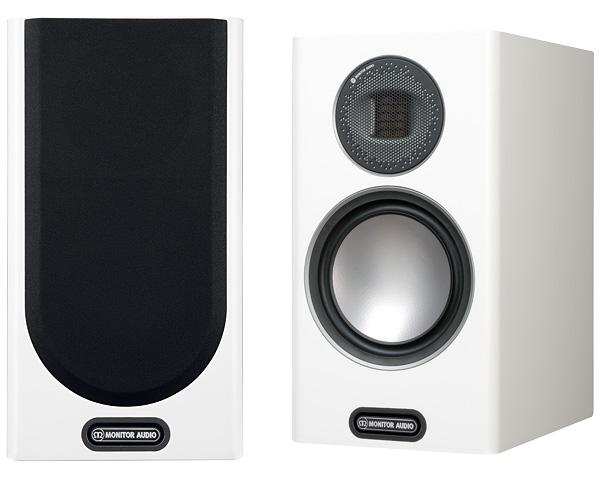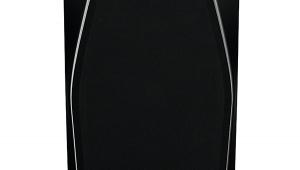Monitor Audio Gold 100 Loudspeakers

 This may be the baby of the latest Gold range, but it has the company's usual impeccable design, fit and finish, and a big sound that belies its compact dimensions
This may be the baby of the latest Gold range, but it has the company's usual impeccable design, fit and finish, and a big sound that belies its compact dimensions
The hierarchy of the Monitor Audio loudspeaker range – starting with Bronze, and progressing through Silver and Gold to the flagship Platinum series – is well-established, and so too is the company's rolling programme of updating the products line by line. In recent times this has run alongside a series of acquisitions – the company scooped up electronics manufacturer Roksan in 2016, and more recently added Blok, the maker of the STAX range of hi-fi stands and AV racks, to its stable.
Now Monitor Audio's updating process has come round again to the Gold models, which hit their fifth generation with a slimmed-down offering of stereo speakers, plus centre and surround models and a subwoofer. Sitting at the entry level of the new lineup, the £1400 Gold 100 sets the pattern for the entire range, this relatively compact standmount coming in a choice of high-quality piano gloss black, satin white, or mirror-matched dark walnut or piano ebony veneers.
Honed For Gold
This is the only standmount design in the new offering, following the recent trend of slimming down product ranges. There's quite a jump up to the next Gold model, the £2900 three-way Gold 200 floorstanders, while the flagship Gold 300 – also a three-way – comes in at £4000 a pair. Filling the gaps – literally so, in a surround sound sense – are the £1100 Gold C250 centre speaker, the £1700 Gold FX, which comes in handed pairs with switchable dipole/bipole operation, and the £2100 Gold W12 subwoofer.
As the model designation suggests, the sub uses a 12in/30cm bass driver, which is driven by a 600W Hypex Class D amplifier module, while onboard DSP provides all the crossover and control settings. The sub also features in-house developed 'Automatic Position Correction', with a microphone provided for room optimisation, and there's a 'SubConnect' app for firmware updates and the like.
By comparison, the 36cm-tall Gold 100 is (almost) a conventional standmount speaker, with optional column stands at £350/pair to which the speakers can be bolted for the closest possible coupling. I say 'almost conventional' because this design is some way removed from the dome tweeter plus paper/plastic cone configuration still common in many speakers of this kind. In this case, as part of Monitor Audio's design/engineering process still carried out here in the UK, the company's drive units are constantly refined and developed.
In fact, the drivers across the fifth-generation Gold series are derived from the Platinum II range, apparently 'especially re-developed and honed for Gold', and mounted in the cabinets using the company's single-bolt rear fixing to give a clean outward appearance.

Ribbon Style
Starting with the tweeter, this follows the current fashion for 'ditching the dome' and replacing it with a ribbon-style driver. Here it's Monitor Audio's own MPD (Micro Pleated Diaphragm) design, the low mass, well-damped diaphragm allowing a wider frequency response, the crossover being centred on 2.5kHz, and with a claimed upper limit of 50kHz/–6dB.
It's partnered with the RDT-II 6.5in/16.5cm mid/bass unit, which may look like one of the company's familiar C-CAM ceramic/metal 'dishes', a design and technology Monitor Audio has been using for many years, and over several generations of its different speaker ranges. However, that impression turns out to be literally no more than skin-deep.
The cone of the RDT-II is driven by a long-throw (11mm) motor, its large diameter magnet, 50mm voice coil and optimised pole all designed for higher power handling, the whole being mounted in a diecast aluminium chassis for rigidity and damping.
Tuning the bass is a single rear-venting reflex port, which utilises the company's HiVe II 'high velocity' tube profile, intended to smooth airflow for tighter bass, while the crossovers use bespoke polypropylene capacitors and both air-cored and low-loss laminated steel-core inductors. The internal cabling, meanwhile, is all 'Pureflow' silver-plated OFC copper.
The Gold 100's cabinets are built from 18mm MDF, and are squarer than the previous curved Gold designs, this made possible by improved bracing again derived from the Platinum II series. With its radiused vertical joints, and a soft-touch top panel, the cabinet finish of the review pair was exemplary, set off by the use of magnetic attachment for the grilles, leaving no visible fixings when the speakers are used 'naked'.
![]() Power Punch
Power Punch
Set up according the manual's instructions, a metre in from sidewalls and at least 30cm from the boundary behind them, I found the speakers needed less toe-in than usual to achieve a stereo image of pleasing solidity. I suspect this is the result of the wide, smooth dispersion of that MPD driver and what appears to be its excellent integration with the mid/bass unit. Positioning them so I could just glimpse the outer side of the enclosures from the listening position seemed to do the trick.

























































